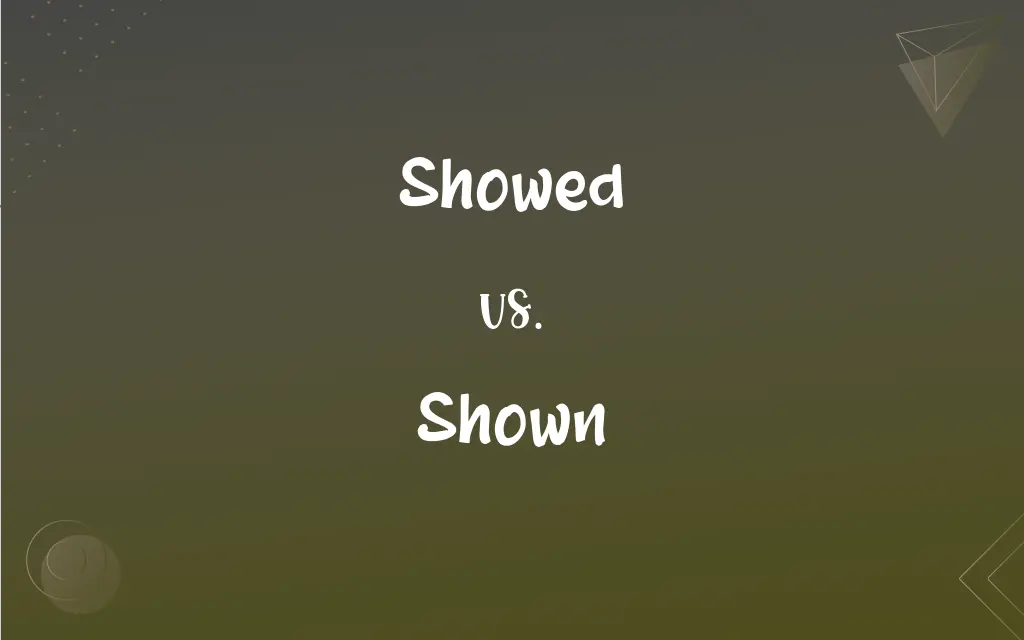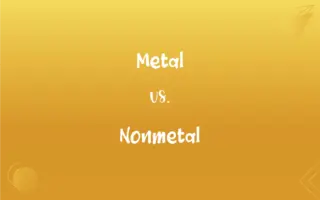Showed vs. Shown: What's the Difference?
By Janet White || Updated on March 4, 2024
Showed is the simple past tense of "show," indicating an action completed in the past, while shown is the past participle, used with auxiliary verbs to form perfect tenses or the passive voice.

Key Differences
Showed is utilized to describe an action that was completed at a specific time in the past. It directly indicates that someone displayed or revealed something to someone else. On the other hand, shown is the past participle form of "show" and is used in various grammatical constructions, including perfect tenses and passive voice, often to indicate an action's relevance to the present or to describe actions in a more general or unspecified time frame.
The choice between showed and shown depends on the sentence's structure and the intended emphasis on the timing or nature of the action. While showed is straightforward and specific to past actions, shown is more versatile, allowing for a broader range of expressions about actions that continue to have relevance or are described in a passive context.
Understanding the difference between these two forms is crucial for conveying the correct temporal context and for achieving grammatical accuracy in writing and speech. This distinction helps in clearly communicating whether an action is confined to the past or has implications extending to the present or is described in relation to its subject or object.
Comparison Chart
Form
Simple past tense
Past participle
Usage
Indicates a completed action in the past.
Used with auxiliary verbs, in perfect tenses and passive voice.
ADVERTISEMENT
Example Sentence
"He showed me the way home."
"The way home has been shown to me."
Temporal Context
Specific to a past time frame.
Can relate past action to the present or describe actions generally.
Focus
On the action and its performer in the past.
Can be on the action's relevance to the present or on the action's object.
Showed and Shown Definitions
Showed
Past tense of "show," indicating past action.
She showed her artwork to the class yesterday.
Shown
Often used in passive constructions.
The path was shown to us by the guide.
ADVERTISEMENT
Showed
Direct action by the subject.
The guide showed us the path.
Shown
Indicates ongoing relevance or unspecified time.
Improvements have been shown over the semester.
Showed
Specific and time-bound.
Yesterday, he showed me the error in the report.
Shown
Connects past actions to present context.
She has shown a consistent dedication to her studies.
Showed
Used without auxiliary verbs.
She showed great skill in her performance.
Shown
Requires auxiliary verbs.
The report has shown the need for further research.
Showed
To cause or allow to be seen; display
Showed us his tattoo.
Shown
Past participle of "show," used for perfect tenses and passive voice.
Her artwork has been shown in many galleries.
Showed
To display for sale, in exhibition, or in competition
Showed her most recent paintings.
Shown
A past participle of show.
Showed
To permit access to (a house, for example) when offering for sale or rent.
Shown
Past participle of show
I had shown him the report already.
The report had already been shown to him.
Showed
To conduct; guide
Showed them to the table.
Showed
To direct one's attention to; point out
Showed them the city's historical sites.
Showed
To make evident or reveal (an emotion or condition, for example)
Showed displeasure at his remark.
A carpet that shows wear.
Showed
To reveal (oneself) as in one's behavior or condition
The old boat showed itself to be seaworthy.
Showed
To indicate; register
The altimeter showed that the plane was descending.
Showed
To demonstrate by reasoning or procedure
Showed that the hypothesis was wrong.
A film that showed how to tune a piano.
Showed
To demonstrate to by reasoning or procedure; inform or prove to
Showed him how to fix the camera.
Showed her that it could really happen.
Showed
To grant; bestow
Showed no mercy to the traitors.
Showed
To be or become visible or evident
Concern showed in his face.
Showed
(Slang) To make an appearance; show up
Didn't show for her appointment.
Showed
To be exhibited publicly
What's showing at the movie theater tonight?.
Showed
To give a performance or present an exhibition
Which artist is showing in the gallery?.
Showed
(Sports) To finish third or better in a horserace or dog race.
Showed
A display; a manifestation
Made a show of strength.
Showed
A trace or indication, as of oil in a well.
Showed
The discharge of bloody mucus from the vagina indicating the start of labor.
Showed
The first discharge of blood in menstruation.
Showed
A false appearance; a pretense
Only a show of kindness.
Showed
A striking appearance or display; a spectacle.
Showed
A pompous or ostentatious display.
Showed
Display or outward appearance
This antique tea service is just for show. His smile was for show.
Showed
A public exhibition or entertainment.
Showed
An exposition for the display or demonstration of commercial products
An auto show.
Showed
A usually competitive exhibition of domestic animals
Won first place at the cat show.
Showed
A radio or television program.
Showed
A movie.
Showed
A theatrical troupe or company.
Showed
(Informal) An affair or undertaking
Ran the whole show.
Showed
(Sports) Third place at the finish, as in a horserace.
Showed
Past participle of show(alternative to shown)
Recent polling has showed that 40% are in favour of the candidate.
Showed
Implies action completed at a specific past time.
They showed enthusiasm during the event.
FAQs
When should I use showed?
Use showed when referring to a specific event or action that happened in the past and is completed.
How does the use of showed vs. shown affect the meaning of a sentence?
Using showed focuses on a specific past action, while shown connects the action to the present or emphasizes the action's object in passive sentences.
When is shown appropriate to use?
Use shown when forming perfect tenses (e.g., has shown, have shown) to relate past actions to the present or in passive voice constructions.
What are some common mistakes when using showed and shown?
A common mistake is using showed in place of shown with auxiliary verbs or vice versa, leading to grammatical inaccuracies.
Can showed and shown be used interchangeably?
No, they cannot be used interchangeably due to their different grammatical roles and temporal implications.
Are there any exceptions to the use of showed and shown?
The rules for using showed and shown are consistent, but understanding their application in complex sentences may require practice.
Is there a difference in formality between showed and shown?
There is no inherent difference in formality; the choice depends on the grammatical construction and temporal context needed for clarity and accuracy.
How can I remember when to use showed vs. shown?
Remember that showed is for specific past actions without auxiliary verbs, while shown is used with auxiliary verbs and in passive constructions.
Can you provide an example where both showed and shown are used correctly?
"She showed me the project last week, and it has shown significant progress since then."
Can "showed" indicate ongoing action?
No, "showed" is the simple past tense and specifically indicates an action that was completed in the past, not ongoing action.
Is "shown" only used in the past tense?
While "shown" is the past participle of "show," it is used in various tenses (past perfect, present perfect, and future perfect) to indicate actions related to different times, not just the past.
What is an example of "shown" in future perfect tense?
An example of "shown" in future perfect tense is, "By next year, she will have shown her art in three different galleries."
Is "showed" ever correct in a perfect tense construction?
No, "showed" is not used in perfect tense constructions. The correct form is "shown" with the appropriate auxiliary verb, such as "has shown" or "have shown."
How does the choice between "showed" and "shown" affect the passive voice?
In passive voice constructions, "shown" is the correct choice, as it requires an auxiliary verb. For example, "The film was shown to the audience."
Why is the distinction between showed and shown important?
Understanding this distinction is crucial for accurate and effective communication, ensuring that the timing and focus of actions are clearly conveyed.
Can "shown" be used without an auxiliary verb?
No, "shown" cannot be used without an auxiliary verb. It is the past participle form and requires an auxiliary verb to form perfect tenses or to be used in the passive voice.
How do I decide whether to use "showed" or "shown" in a sentence?
Decide based on the sentence's tense and structure. Use "showed" for simple past actions, and "shown" when an auxiliary verb is present or in passive voice constructions.
What is a tip for mastering the use of "showed" and "shown"?
Practice writing sentences in different tenses and voices, paying close attention to the context and requirements for each form to improve understanding and usage accuracy.
Why might someone mistakenly use "showed" instead of "shown"?
Mistakes often stem from confusion over tense requirements or the distinction between simple past and past participle forms.
Can "showed" and "shown" be used in the same narrative?
Yes, both can be used in the same narrative, depending on the actions' timing and context within the story.
About Author
Written by
Janet WhiteJanet White has been an esteemed writer and blogger for Difference Wiki. Holding a Master's degree in Science and Medical Journalism from the prestigious Boston University, she has consistently demonstrated her expertise and passion for her field. When she's not immersed in her work, Janet relishes her time exercising, delving into a good book, and cherishing moments with friends and family.































































